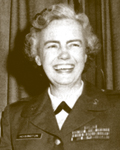Elizabeth P. Hoisington, who led the Women’s Army Corps through a period of dramatic change in the 1960s and ’70s and was one of the first two women in the U.S. military promoted to the rank of Brigadier General, died of congestive heart failure August 21, 2007, at an assisted-living facility in Springfield, Virginia, where she lived. She was 88.

At a Pentagon ceremony on June 11, 1970, Hoisington and Anna Mae Hays of the Army Nurse Corps became the first two women in the United States to have a brigadier general’s star pinned on their shoulders.
Their promotions were a public relations coup for the Army. A photograph of General William Westmoreland, the Army chief of staff, kissing Hoisington at the ceremony was featured in newspapers and in the World Book encyclopedia.
She and Hays appeared on the Dick Cavett, David Frost and “Today” shows, and Hoisington — who possessed a bright smile and an outgoing personality — was a guest on the popular game show “What’s My Line?”
Hoisington, who came from a military family, enlisted in the old Women’s Army Auxiliary Corps in 1942 and quickly proved a talented, organized and well-liked officer.
In 1966, during a period when the role of women was changing as much in the military as in society at large, she was named director of the Women’s Army Corps.
She was proud that during her five years leading the WAC, the number of women in the service rose from fewer than 10,000 to almost 13,000. Their duties, once largely secretarial and supportive, expanded to include intelligence, electronics, personnel administration and air traffic control.
“She was a great leader,” Hays, her fellow brigadier general, said of Hoisington in an interview last week. “She was really well-loved. She was held in great respect.”
The Women’s Army Corps remained a distinct branch within the Army until it was abolished in 1978 and women assumed duties alongside men.
Although presiding over a time of fast-moving change, Hoisington also saw herself as a guardian of the traditions and honor of the women’s corps.
As the Vietnam War progressed, married women were allowed to serve in the WAC, pregnant women were granted leave and some legal infractions were overlooked. Previously, any of these circumstances would have led to immediate discharge.
She was adamant that women should never play an active role in combat.
“The women libbers,” she said in 1990, “are still a little vocal as to why they can’t go into combat. I don’t think the people of the United States want that.”
Elizabeth Paschel Hoisington was born November 3, 1918, in Newton, Kansas. Her grandfather had helped found the Kansas Army National Guard, and her father was an Army Colonel and a marksman.
As a young girl, she rode horses and learned to shoot with her father.
In 1940, Hoisington graduated from the College of Notre Dame of Maryland in Baltimore with a degree in chemistry.
When the women’s corps was established in 1942, she was eager to enlist.
“The minute she heard about the WAC, she wanted to join,” said her sister, Nancy Smith of Annandale, Va. “She went in as a private and came out as a general.”
An older brother, Perry Hoisington, was a Major General in the Air Force, making them the country’s first brother and sister generals.
Sent to Europe in 1944, Hoisington was among the first U.S. women to set foot on French soil after the D-day invasion. At the Potsdam conference after the German surrender in May 1945, she helped organize the telephone system.
Hoisington was executive officer of a WAC battalion in Tokyo from 1948 to 1950, then served at the Pentagon and at a post near San Francisco until 1964. She was commandant of the Women’s Army Corps School at Ft. McClellan, Alabama, before assuming command of the corps.
When she retired in 1971, Hoisington became only the third WAC to receive the Distinguished Service Medal. Her other decorations included two awards of the Legion of Merit, the Bronze Star Medal and the Army Commendation Medal.
In addition to her sister, survivors include a brother, retired Army Lieutenant Colonel Col. Robert Hoisington of Huntsville, Albama.
Hoisington never married. “The Army is my first love,” she said in 1970.
General Hoisington was buried with full military honors in Arlington National Cemetery on 7 November 2007.
Note: The General’s father, Gregory Hoisington, Colonel, United States Army, is also buried in Arlington National Cemetery. Her youngest brother, Gregory Hoisington, Jr., First Lieutenant, United States Army Air Corps, was killed in a 1941 automobile accident and is also buried in Arlington National Cemetery.
Michael Robert Patterson was born in Arlington and is the son of a former officer of the US Army. So it was no wonder that sooner or later his interests drew him to American history and especially to American military history. Many of his articles can be found on renowned portals like the New York Times, Washingtonpost or Wikipedia.
Reviewed by: Michael Howard
